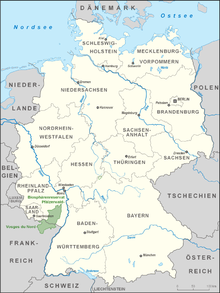Palatinate Forest-Vosges du Nord biosphere reserve
The Franco - German Biosphere Reserve Palatinate Forest-Vosges du Nord (German actually Biosphere Reserve Palatinate Forest-Northern Vosges , French Réserve de biosphère transfrontalière des Vosges du Nord-Forêt palatine ) was designated in 1998 as the first cross-border biosphere reserve by UNESCO in Europe . The German part was the 12th of 16 biosphere reserves in Germany and the French part the 6th of 14 in France.
geography
Geographical location
The biosphere reserve is located in the Palatinate Forest and in the northern Vosges at the interface between the southwest German state of Rhineland-Palatinate and the north-eastern French region of Grand Est .
Size and structure
The total area of the biosphere reserve is 310,500 hectares. Of this, 180,000 hectares are in the Palatinate Forest Nature Park in Germany and 130,500 hectares in the Northern Vosges Regional Nature Park ( French Parc naturel régional des Vosges du Nord ) in France. The largest part consists of forests, as they also prevail in the entire mountain range of the Palatinate Forest and Vosges. The forest makes up about 74% of the area, the populated part of the area is only 5%.
history
In 1983, the owners of the Palatinate Forest Nature Park and the Northern Vosges Regional Nature Park began to consider connecting German and French hiking trails across borders and designating them accordingly. In 1985 a joint agreement was signed for the two nature parks to work together. In 1989 the Northern Vosges Regional Nature Park was recognized as a biosphere reserve by UNESCO, and in 1992 the Palatinate Forest Nature Park was recognized as a biosphere reserve. In 1996, a Franco-German agreement was signed to create a biosphere reserve Palatinate Forest-Northern Vosges , which was recognized by UNESCO as a cross-border biosphere reserve in 1998.
Zoning
Legal requirements
In accordance with the zoning prescribed by UNESCO, core zones are designated in which any use is excluded. These are areas that represent significant natural heritage and whose sustainable protection is required.
In addition, maintenance zones are defined in which only gentle, natural land use may take place, provided that this does not impair their natural heritage. All other parts of the area are development zones .
implementation
In the Palatinate Forest, core zones from forest areas were established, some of which were already protected. Maintenance zones that adjoin the core zones have large proportions of existing nature reserves. Development zones contain the more intensively used areas or settlement areas.
In the Northern Vosges, core zones were formed from existing nature reserves or those in the process of being established, which are scattered over the entire area. Care zones mainly consist of forests and valleys, development zones of towns and industrial areas.
Sponsorship and institutions
Germany

In the first few years, the registered association Palatinate Forest Nature Park acted as the supporting organization for the German part of the biosphere reserve in accordance with Section 6 of the Territorial Ordinance . Members of the association were those districts and urban districts that had a share in the biosphere reserve in terms of area, as well as the district association of the Palatinate as well as various hiking, sports associations and environmental associations. This should guarantee independence from individual specialist and regional interests. The aim of the association was to develop the biosphere reserve uniformly and to maintain and maintain its uniqueness and beauty as well as its supraregional recreational value. The office of the biosphere reserve has been based in Lambrecht (Palatinate) since 1997 .
The sponsoring association Naturpark Pfälzerwald e. V. was dissolved by a resolution of its general assembly of December 4, 2013 on December 31, 2013 and its tasks were transferred to the District Association of the Palatinate. The formal resolution was passed at a meeting of the Palatinate District Assembly on December 20, 2014 at Hambach Castle, so that the Palatinate District Association has assumed sole responsibility since January 1, 2014. The office of the Palatinate Forest Nature Park and the German part of the biosphere reserve will remain in Lambrecht. As part of the organizational restructuring, a committee with 20 members was formed, which is primarily responsible for the various interests of the biosphere reserve. In addition to representatives of political organizations, it also includes five members who previously belonged to the nature park board. They are representatives of the Palatinate Forest Association (PWV), the Association for the Environment and Nature Conservation Germany (BUND) , the Pollichia Association for nature research and conservation , the Association of Friends of Nature and the nature sports associations .
The House of Sustainability in Johanniskreuz in the center of the Palatinate Forest serves as a visitor information center for the biosphere reserve. Another visitor information center is located in Fischbach near Dahn and has several parts: In the biosphere house , a multimedia exhibition makes biological and ecological basic principles vividly and playfully tangible. The Fischbach treetop path zigzags through the forest at an average height of 18 meters; platforms at a height of 35 meters offer a view of the Palatinate Forest from above. An approximately two kilometer long biosphere adventure trail through the Spießwoogtal connects twelve hands-on stations that provide visitors with interesting information about nature, landscape and habitats.
Biosphere house in Fischbach near Dahn
France
Of the 115 municipalities in the Grand Est region that make up the French part, two thirds belong to the Bas-Rhin department in the east and one third to the Moselle department in the west. They have joined forces to form the Syndicat de coopération pour le Parc (Sycoparc) . The administrative center of the nature park with an attached museum is located in La Petite-Pierre ( German Lützelstein ).






